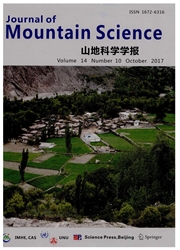

 中文摘要:
中文摘要:
这篇文章在西藏从 Nam 公司湖的平台在二土壤侧面调查土壤性质,中国。与到东方的一个斜坡方面,侧面 1 是 37 m,并且到西南,侧面 2 是在湖水平上面的 32 m。分别地, 12 和九层基于颜色,质地,结构,潮湿内容,碳酸盐的存在,和根密度在侧面 1 和侧面 2 被识别。水内容,全部的器官的碳,全部的无机的碳,全部的碳, pH 价值和电的电导率的谷物尺寸和大小都为每件样品被分析。结果证明因为在冷、干旱的区域捱过的稀少的植被范围和弱化学药品,土壤糟糕被开发。结果也显示土壤性质在二侧面之间是不同的并且建议土壤更好在比在侧面 2 的侧面 1 被开发。这些差别被归功于到地形的不同,植被并且预定。侧面 1 作为与侧面 2 相比面对到东方面对到西南并且得到更少的曝晒并且因此更少的蒸发。因此,植被在比在侧面 2 的侧面 1 更好成长。标明日期的放射性碳和介绍 1 的 OSL 标明日期表演比介绍 2 经历了形成过程的更长的土壤,它对在侧面 1 的土壤发展有用。
 英文摘要:
英文摘要:
This article investigates the soil properties in two soil profiles from the terraces of the Nam Co Lake in Tibet, China. Profile 1, with a slope aspect to east, is 37 m, and profile 2, to southwest, is 32 m above the lake level. Twelve and nine layers were identified in profile 1 and profile 2, respectively, based on the color, texture, structure, moisture content, presence of carbonate, and root density. Grain sizes and measurements of water content, total organic carbon, total inorganic carbon, total carbon, pH value and electrical conductivity were all analyzed for each sample. The results show that soil is poorly developed because of sparse vegetation coverage and weak chemical weathering in the cold and arid area. The results also indicate that the soil properties are different between the two profiles and suggest that soil is better developed in profile 1 than in profile 2. These differences are ascribed to the dissimilarity of landform, vegetation and timing. Profile 1 faces to east as compared with profile 2 facing to southwest and gets less insolation and therefore less evaporation. Thus, vegetation grows better in profile 1 than in profile 2. Radiocarbon dating and OSL dating show that profile 1 underwent a longer soil forming process than profile 2, which is helpful for the soil development in profile 1.
 同期刊论文项目
同期刊论文项目
 同项目期刊论文
同项目期刊论文
 AN INTRODUCTION TO THE PHYSICAL GEOGRAPHY OF THE QIANGTANG PLATEAU: A FRONTIER FOR FUTURE GEOSCIENCE
AN INTRODUCTION TO THE PHYSICAL GEOGRAPHY OF THE QIANGTANG PLATEAU: A FRONTIER FOR FUTURE GEOSCIENCE Properties and periglacial processes in alpine meadow soils, western Nyainqentanglha Mountains , Tib
Properties and periglacial processes in alpine meadow soils, western Nyainqentanglha Mountains , Tib Nature,genesis and provenance of silt pellets on the ice surface of Glacier No.1, upper Urumqi River
Nature,genesis and provenance of silt pellets on the ice surface of Glacier No.1, upper Urumqi River Review of Holocene glacial chronologies based on radiocarbon dating in Tibet and its surrounding mou
Review of Holocene glacial chronologies based on radiocarbon dating in Tibet and its surrounding mou Last Glacial Maximum climate inferences from integrated reconstruction of glacier equilibrium-line a
Last Glacial Maximum climate inferences from integrated reconstruction of glacier equilibrium-line a Lake-level fluctuations since the Last Glaciation in Selin Co (lake), Central Tibet, investigated us
Lake-level fluctuations since the Last Glaciation in Selin Co (lake), Central Tibet, investigated us Relationships between the heights of moraines and lengths of former glaciers in Tibet and surroundin
Relationships between the heights of moraines and lengths of former glaciers in Tibet and surroundin 期刊信息
期刊信息
